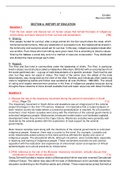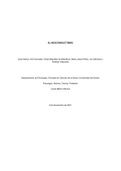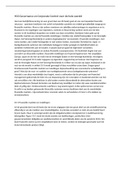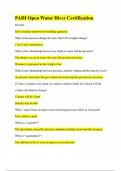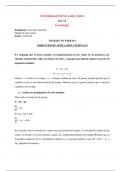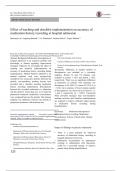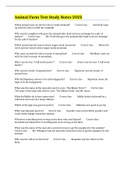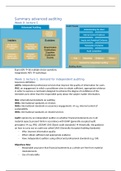ICH4801
May/June 2022
SECTION A: HISTORY OF EDUCATION
Question 1
From the text, select and discuss two (2) human values that formed the basis of indigenous
communities, and were relevant for their survival and socialization. (15)
a) Sharing,
Khoi people hunted for survival, after a large animal kill, the San would share the meat, which
reinforced social harmony. After any celebration or successful hunt, the meat would be shared in
the community and everyone would eat for survival. In this way, indigenous people looked after
one another. Even those who had nothing were given meat, this is according to Ubuntu values.
Sharing the meat was a social duty and not a method of resource conservation. They distributed
and divided the meat amongst each other.
b) Respect
The Khoi and San lived in communities under the leadership of chiefs. The Khoi, in particular,
lived in a basic round structure called a matjieshuis (Mountain, 2003:42) with an encampment from
the same patrilineal clan – a group of male descendants of a specific ancestor. Each had his own
clan, but they were not equal in status. The head of the senior clan, the eldest of the male
descendants, was recognized as the chief of the tribe. Families and individuals often made long
visits to neighboring bands and friction was avoided at all cost (Huffman, 1986:280). The virtues
of caring and respect were common practice in the lives of indigenous peoples because during
droughts these networks of clans shared available food and water resources with distant families.
Question 2
2.1 Review the role of the missionary movement during the period of colonization in South
Africa. (Page 73) (7.5)
The missionary movement in South Africa and elsewhere was an integral part of the colonial
project that begun in the mid-17th century. However, it is imperative that a careful analysis of
each mission society be made before a conclusive generalization is reached. As a Eurocentric
movement, most mission societies went along with the intentions of the colonial governments to
colonized indigenous people. Missionaries introduced modernization and facilitated capitalist
development when they arrived at the Cape Colony. Missionary societies were generally well
received by the colonial powers with the expectation of loyal support by the colonial
governments.
Most mission societies went along with the intentions of the colonial governments to colonized
indigenous people. However, there was a counter to this trend. For example, Lovedale and
some missionaries acted contrary to this trend and thus affirmed the dignity and value of
indigenous people. The educational efforts, although not perfect, were considerable, especially
in teaching and training of indigenous people. These movements evolved into anti-colonial
opposition with the realization and experiences of entrenched racism and rejection of African
epistemologies and cultural practices by missionaries.
2.2 With reference to the role of the Moravian missionary movement, critically discuss their
contribution to South African education. (7.5)
Georg Schmidt founded a mission station at Baviaanskloof which was later renamed Genadendal
(Valleyof Grace). The station was about 80 km east of Stellenbosch and it provided elementary
education andtraining to the Khoikhoi adults and children. Three missionaries joined Schmidt at
, 2
ICH4801
May/June 2022
Genadendal and they established a church, workshops, schools for religious instruction and
training for agriculture (Lewis & Lemmer, 2004:59). Tensions ensued between Georg Schmidt
and the DEIC. The Dutch Reformed church was a church for the colonists and both the church
and the colonists thought that Schmidt was not ‘pure in faith’ and could not therefore uphold
Dutch Reformed church doctrine. Moravian Mission Society treated the Khoikhoi as friends and
equals and proposed to give them an education that was not available to settler children. The
Moravian Mission Society expanded its territories to the western and eastern areas of the Cape.
(15)
Question 3
Appraise the history of education in Africa with reference to the Timbuktu libraries in Mali. In your
answer, refer to the significance of these libraries and the role of South Africa in the preservation
of the old manuscripts. (10)
South Africa’s role in the preservation of the Timbuktu manuscripts.
Despite UNESCO's interest in the restoration of the Timbuktu libraries, the project was given a
major boost in the early 21st century when interest in it was rekindled by former South African
President Thabo Mbeki. The former president visited one of Timbuktu's main institutions, the
Ahmed Baba library in 2001. Ahmed Baba (1556-1627) is perhaps the best known of Timbuktu's
scholars. His family were scholars, judges and legal philosophers in the 1500s and he studied
under his father and grandfather. The family library was large, but his own library was
considered small containing only 1 600 manuscripts. As a student he had to study works of
grammar, mysticism and Muslim law. During the Moroccan conquest of Timbuktu in 1593,
Ahmed Baba was exiled from Timbuktu. He later returned as a scholar. He wrote approximately
50 to 60 texts, including philosophical writings on power and knowledge, law, and the
enslavement of Africans.
On realising the wealth of knowledge in need of conservation and restoration, Mbeki promised
to conserve the thousands of manuscripts held in Timbuktu at the Ahmed Baba Institute (Jeppie
& Diagne, 2008). This promise from South Africa was an expression of Mbeki's 'African
Renaissance' philosophy which he expounded in his famous 'I am an African' speech in 1996
(Jeppie & Diagne, 2008). Mbeki's vision of an African Renaissance is the antithesis of the
dominant Afro-pessimism. According to Mbeki, intellectual and cultural exchanges are as
important as the political and economic collaboration needed to strengthen African capacity. It
was from this commitment to a vision of African renewal that a South African project on the
Malian manuscript history was initiated. Historians and academics all over the world, including
those at the University of Cape Town, are translating the Timbuktu manuscripts as part of the
Presidential Lead Project (Iziko Museum, 2008).
Question 4
Critically evaluate the Harambee (Kenya) and Ujamaa (Tanzania) educational projects in terms
of their relevance for the South African decolonization movement. Refer to the challenges
experienced by schools in rural areas, and state what lessons South Africans can learn from
the past. (10)
Education for Self-Reliance (ESR) was the most important educational principle, which
presented the educational philosophy of Tanzania. The purpose of ESR was to set down
principles of education, which would serve as a revolutionary influence in the creation of the
new social society. ESR is about gaining self-independence, responsibility and democratic
involvement; it is education, which is meant to liberate individual from over-reliance. However,
the extent to which education in most African countries like Tanzania has been able to meet its
objectives in terms of creating a sense of independence is still speculative.

